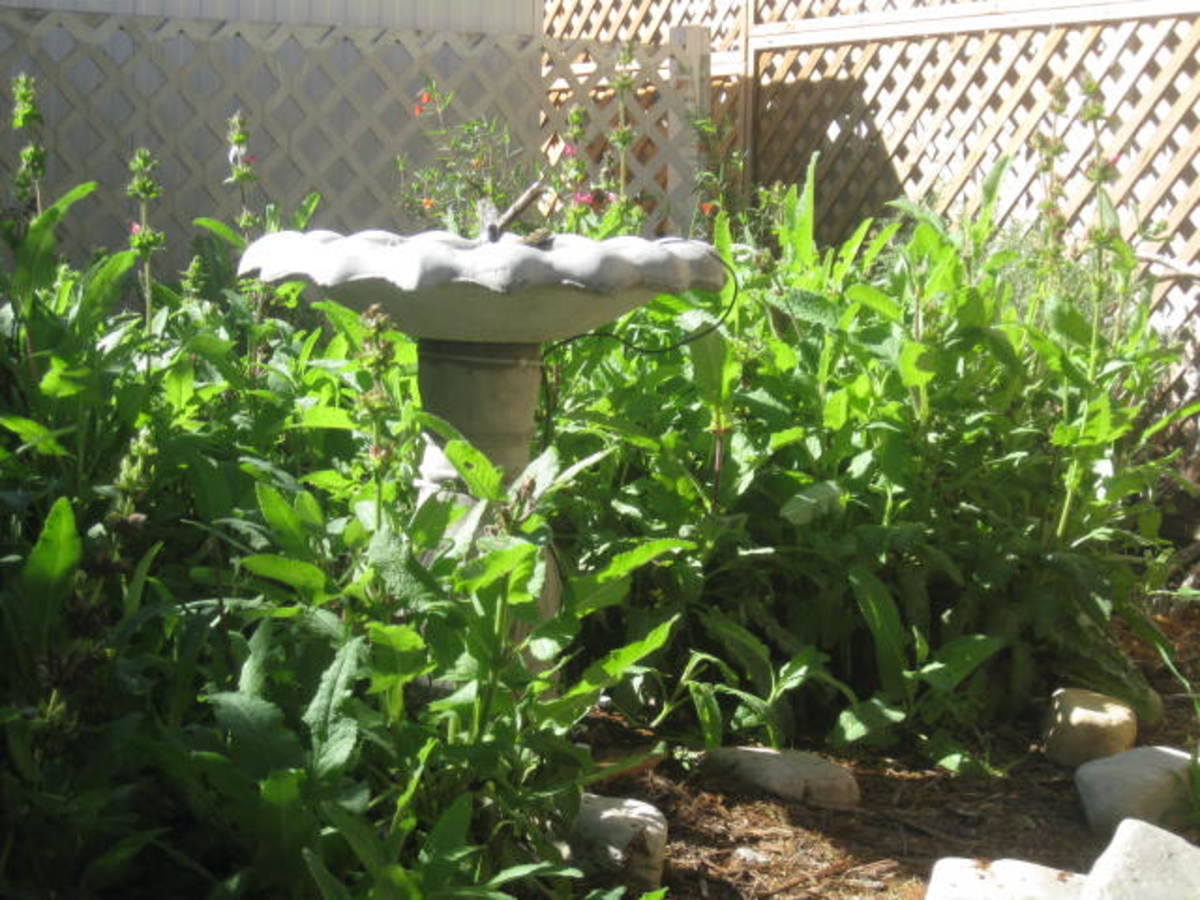Chic gardening
How to avoid getting planted by fashionable gardening
Starting with the basic premise that what people grow in their own gardens is their own business, it has to be said that both style and technology intrude if they get the chance. Given the vast advances in biological science, the desire to play God can’t be far away. There’s an insidious tendency on the part of the industry to intrude with novelties, gadgets, and the sort of hack advertising that makes people think they can’t live without them. As discussed above, the normal version of this is tiresome décor, soggy management-seminar level orientation to design concepts, and a supply of third rate materials.
If that isn’t warning enough, consider:
1. Everything ever designed as a consumer item usually turns out to be substandard.
2. Virtually everything in a normal household can be lethal with a little effort.
3. All of the above is expensive to maintain, repair, and operate.
4. Anything not covered by case law or statutes can drag on for years.
None of which has prevented the daily flood of consumer goods being rammed delicately into everyone’s lives. On of the big selling points of anything is that it’s “new”. The need to have the latest of everything is probably the best possible example of a social inferiority complex applied in practice. In gardening, this syndrome has branched out recklessly into Chic Gardening, the pursuit of novelty at any price. Primulas able to sing The Hallelujah Chorus are only a punnet away. Privet hedges able to park the car and lawns able to mow themselves while conducting ballet classes may be safely assumed to be on their way.
Actually putting a bit more absurdity into modern life does have a few things to recommend it.
Consider the possibilities of one of your more bovine acquaintances trying to tame a jazz-playing lavender. A car salesman earnestly explaining the benefits of All Wheel Drive to a petunia. Your sedge getting arrested for shoplifting. You could make a fortune in chat show appearances discussing what’s likely to happen to the plumber when the Agapanthus realized he was disconnecting the outlet from the bathroom.
But…
Does one want to live among the idiocies of consumerism? Entertaining as the sight of a tree devouring a suburb is, surely we could do more to enhance the life of the tree than just allowing it to play with any old rubbish. The lavender might well be the next Mingus, and the petunia a better motorist than most. The sedge could become a sort of clumpy Robin Hood, and the Agapanthus could make the most wanted list look a bit nicer, but is that all we expect from designer plants, to merely make do with suburbia as a venue?
One of the problems with Chic Anything is that it’s usually Chic devoid of practicalities. In terms of the garden, it’s also usually Chic lacking anything useful or tolerable. In the arts, Chic is normally a synonym for insufferable. While forgivable in anyone with any talent under about 25, the conceit is a bit much for the art lover.
Ergo the garden lover is usually a bit less than impressed with the normal run of Chic Everythings, even in the normal forms. The “new” rose is a transparent mix of older cultivars, and the name, “Smarmy Goo Goo” lacks a certain poise. The Black Spot factory seems to be much the same, and the thing may or may not flower properly. This wonderful product is inevitably the latest thing in rose design. It has been praised more than the latest hit movie, and credited with saving lives and starting a few cults, and it’s still rubbish. The main selling point remains that it’s new, not that it’s any sort of actual improvement.
In all honesty, anything really Chic usually starts as a sort of accident. Cookery is a case in point. A bit of incinerated mammoth translated into a major industry and the cause of more sincere cursing than any commercial ever run. Fake Chic is usually the result of some sleazy desire to flog merchandise, and it shows. Like Pop Art, it has no depth and no basis. Care to guess what 90% of Chic is, at any given moment in history?
So it follows that Chic Gardening is going to be a horror of epic vistas. A plant that looks like a hamburger or a can of soup isn’t impossible, it’s just that nobody with sufficient lack of taste and class has yet evolved to produce them.Nor is it impossible that something with leaves like Van Gogh’s Wheatfield With Crows will be grown for its rustic charm, and dear tiny little flowers that look like price tags.
It’s interesting that modern design tends to come in outcrops. There will be an architectural Renaissance, followed by a décor revolution, followed by cheesy packaging innovations. You can start in a life of soap operatic innocence in your Gothic apartment eating gruel and wearing things that look anonymous in crowds. You then progress to living in something very like a Necro Diner eating slop amid that original lifeless modern supermarket look most of the Baby Boom generation grew up in, and wearing the results of advanced alcoholism. In middle age you advance to the wholesome cheapness that only real architectural mediocrity can hope to achieve, eating something requiring a degree in food technology to understand and wearing the aberrations of fashion designers whose shoes are smarter than they are. In old age you progress still further into the depths of lifestyle among the restful shades of places designed specifically for those who need to be containerized. You eat a balanced diet of medications and occasionally something which might theoretically be digestible. You wear by now only what’s comfortable.
In gardening, the equivalent is a sort of Grow Your Own Cliche, and that's where Chic Gardening really hits top gear. The fun is programmed, the plants are usually neurotic things that believe their own publicity, even if nobody else does, and the result is Chic Atrocity.
Seems to me that you might as well start by making yourself comfortable, and simply ignore the rest of the process. As land sizes relative to buildings shrink, and the laughable mentalities of those who design living space becomes more infected with the belief that everyone lives in a sitcom with compulsory squalor, the garden has become something which is seen more as art deco than a design feature. Chic Gardening tends to reflect this inferior thinking.
So you see the beginnings of Neo Garden Art. Sometimes unkindly and inaccurately referred to as Train Set Planning, the hideous procedure of Neatness settles in. Add to this the invention of increasingly garish and unnatural garden features, and you can assume that senility of the species is well advanced. A “piece” will appear, a “feature” like a table setting, will slither into the postage stamp sized garden area. Usually it will be known by some restrained market description like Cosmic Phallus, or Credit Card Symbiote, and look like the remains of a car accident. It will be made by some hitherto unknown genius called Gushette Maximus, and be duly revered as a breakthrough in domestic life, the entrance of Culture onto the previously barren stage of human existence. If this unavoidable eyesore is a plant, it will inevitably be the most daring thing in gardening since plastic daisies. It will be written up for centuries afterward as a symbol of the great artistic masters of the day.
Jerome K Jerome, author of Three Men In A Boat, (If you haven’t read it, rush out immediately and get a copy. If nothing else it will explain England to you. Nothing else will...) wrote about the domestic horrors of his day, including the revered Willow Pattern in much the same way. He wondered if the commonplaces of his day would become hallowed a hundred years from then. I was reading him almost exactly a hundred years later, and I can see what he meant. It is a process of acceptance, the valuing of things as what they represent, not what they actually are. He wondered if Willow Pattern would be revered 100 years from 1888.
(I’m actually eating ANZAC biscuits out of a Willow Pattern saucer as I write… fate, eh? The Willow Pattern has since degenerated into a rather tacky imitation of its original self, a mere series of smears under the glaze, no life or personality in them. I got lucky and found an old piece that actually looks like real Willow Pattern.)
That’s a fairly good analysis of the design process. Chic Gardening takes advantage of both the marketing and the fact that anything old enough is usually considered “art”, however bloody awful it is. Arguably no form of artistic pretension could survive without it. It’s just that the human race brings this unspeakable irritant with itself wherever it goes. Hence the remains of some gruesome excess will sit in the garden for centuries, in some cases, protected by archaeologists and other masochists.
My father was an industrial designer, among other things, so I’m not quite so impressed with this mongrelization of ideas. I know they’re not new. Venus Rising From The Styrofoam doesn’t strike me as particularly inspiring, or inspired. Nor does a garden shed looking like the Sistine Chapel and costing as much necessarily transport me to Valhalla. Nevertheless, even a professional cynic who practices regularly will look at something “new” because it is “new”, at least in theory.
That’s the trap. Where the wallet goes, the mind will follow……eventually. Chic Gardening generally dumps large amounts of new looks, new shapes, new products, and new books about itself onto the gardener. That they lack substance is obvious, but look at what’s happened. Centuries’ worth of perfectly good, reliable ceramic pots have been replaced by seconds’ worth of bland little plastic things. The slightly prudish garden statuary has been supplanted by Objéts De Anonymous, personality-less things with no known purpose or aesthetic
The culture creates the art, which is rather a pity. Whole generations are raised
in the squalid piles of concrete we are told are normal human habitations
called cities. The mental
restrictions are arguably much worse, and they're the basis of Garden Art as it is now called, blending with an unspeakable environment.
We appreciate….sometimes, if
we can.It's just that I'm pretty sure the basic idea of gardening isn't to provide a wreath for the funeral of human aesthetics.
The art analogy isn’t entirely misplaced. Art suffers from the artist, as well as the aficionado. Art is often misrepresented as something it simply isn’t. Cultural events, art exhibits or gardens, are occasionally touted as tours de force when they’re really tours de farce. The thunderous rote praise is usually an omen of the mediocrity to come.
People have every right to their own aesthetic values, and I’ll never say otherwise. However, there are some chic gardening motifs that deserve to be questioned:
The Modern Desert With Flowerpots.
The pot garden can be a lot
of fun, and can be done truly brilliantly. It is also unique for its ability to
completely defeat its own purpose.Chic gardening invariably includes a range of pots which are probably better for attracting fungi and diseases than growing anything but excuses.
Unless a major breakthrough in the construction of really intelligent flowerpots happens soon, pots have their limits. The pitiful spectacle of a pot bound plant is so familiar and so obvious that I’m wary of mentioning it, but pots will kill plants as efficiently as neglect.
Plants naturally don’t grow in pots. They don’t have credit cards so they can go to the nursery and buy their own, so they’ve learned to make do without. The pot is a potential prison. A life sentence, or a death sentence, in fact, if the gardener isn’t careful.
Some pots are truly useless; the cheapo variety, thin black plastic, are genuinely dangerous for the plant. The roots will cook with a bit of help from the black plastic, if left in the sun. (Metal planters are equally deadly, and dangerous to you, too, if heated up enough.)
Thin plastic anything is well worth avoiding in pots, however chic. Better quality pots are thicker, with a feel of real durability.
Terra cotta is generally
reliable, and breathes better, allowing some movement of air and water when the
potting mix isn’t impacted, but they are very heavy and very breakable, and
should only be handled by those that know how.The "Spanish look" can give you a hernia. It may be chic, but it's growing more chiropractors than plants. Use a hand truck.
Big pots should be handled by those who are insured. Weight is a real issue, particularly after watering.Some plants must have large pots, and you'll be astonished to hear that most of the more fashionable big pots are useless as anything but shop displays.
Indoor chic
Size does matter. Small pots
are for small plants. They can also make small plants out of big plants, and do
enough damage to make repotting a real problem. Anyone who’s ever tried to
unravel a pot bound plant knows the story.The equation is "plant first, decorative values of pot last".
Pot plants in unsuitable containers can get sick pretty easily. You can slaughter all your plants by weakening a pot plant to the extent it gets a disease and passes it on to the others.
Even the fertilizer trade has its uncharacteristic chic moments, particularly with indoor pot plants. Using a lot of whizzbang nutrients is a great way of growing molds and fungi, and with a little effort a healthy crop of mysterious afflictions will keep you very busy and help keep your asthma and hay fever feeling appreciated.
The Deco Garden
The idea of garden décor has been a great boon to those that sell garden décor, and almost nobody else. Between modern sculptures, charming bric-a-brac and entirely forgettable odds and sods, the only thing that can be safely said is that it prevents cluttering up the garden with plants.
There is an interminable supply of Little Things To Hang About The Garden, and Designer Planters for that primary school look.
It’s your garden. If nothing makes you happier than to have a plaster something-or-other sitting in the ivy, please have one. Have many. Otherwise most of this stuff is about as useful as a whale in a bathtub, and far less interesting. Have what you like, not what is thrust upon you. Therein the essence of motifs.
The Machine Garden.
No, not a supply of cars being fixed in the back yard, but a programmed garden, growing according to a plan. As mentioned above, there are plenty of arguments in favor of at least looking at design ideas through a computer.
But- there’s something irritating about the predictable. From predictable to dull as a fence post is a very small step. It also achieves the straitjacket effect of preventing much else being done. If you live in a place where you have scope to design, remember that you might want to design something else sometime, too. Ideas have to grow, too.
Formality uber alles.
There is a theory which I’ve been spreading that formal gardens are a sort of efficient masochism. Like wearing a tuxedo to breakfast, there is a degree of “demanding self image” placed on the gardener. The formal styles are out of fashion these days, and one of the reasons for that is that they are unbelievably expensive, and require a technical expertise that few people either have or can afford. They are the incarnate form of garden perfectionism. They can also be rather an atavism, something out of its time.
They were designed to cater
for large areas, like the Palace Of Versailles, and the smaller chic versions tend
to look window-box-like. An array of plants in formal rows looks great en
masse, in a large setting, but it’s not the same, jammed against the garage,
sandwiched between the car and the hose. If you don't happen to have a Palace of Versailles, consider other options.
Uniformity is a rarity in
gardens these days, and with good reason. People don’t have the space to play with, and they want to
look at more than one plant. The serried ranks of daffodils were an icon once,
but even then they were set amid other features. Chic gardening now produces images which are related to formal gardening, and require an army to grow and maintain. Avoid.
Formal
gardens emphasize their own failures, too. A few plants missing is a conceptual
disaster. Even the shapes are arcane. The garden palette is made not only
formal but symmetrical, and the mind is as likely to just see the symmetry and
ignore it, because it’s too deliberately symmetrical, as it is to look
further. Repetition makes the mind less interested. Chic gardening, like commercials, works on the predictability as the garden's raison d'etre, believe it or not. Anyone can be persuaded they know what they're doing if it's banal enough.
If you want to be an chic gardener, make sure it’s your idea of chic, not the marketing industry’s latest attempt to prove it’s ever seen a plastic daisy.






